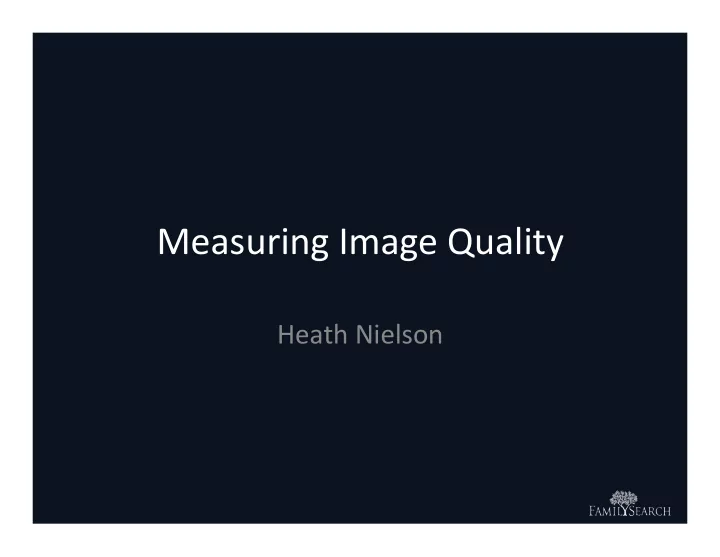

Measuring Image Quality Heath Nielson
Measuring Quality What • Iden7fy and measure a9ributes of an image that can be used to determine whether the perceived quality meets the expecta7ons of the organiza7on.
Measuring Quality Why • Should be part of any document processing system • Guarantee consistency • Useful for iden7fying upstream process problems – Manual – Automated
Measuring Quality How • Subjec7ve – Easy to do – Not always predictable nor consistent • Objec7ve – Predictable and consistent – Hard to measure
Audit Brute Force
Audit Excep7on Based
Contribu7ng factors affec7ng quality • State of original document • Digi7za7on – Resolu7on – Ligh7ng – Exposure – Focus • Post‐processing – Rota7on – Cropping – Contrast enhancement – Lossy compression
Quality Standards DIRT (Digital Image Research Team) • Composed of opera7onal and development personnel • Iden7fy image a9ributes affec7ng quality • Provide, where possible, metrics to measure those a9ributes • Determine acceptable ranges for a9ributes • Provide tools and training to facilitate consistent quality
Quality Standards DIRT Specifica7on • Defines image a9ributes and desirable values for each – Tonal Range – File format – Tonal Resolu7on – File name – Even Exposure – Dimensions – Spa7al Resolu7on – Size – Contrast – Complete Capture – Colorspace – Orienta7on – Focus – Skew – Blur – Fixity
Subjec7ve Evalua7on • Direct Numerical Category Scaling – Subjects classify images into a number of categories – Usually use a numerical scale e.g. (1=Bad, 5=Good) – Subjects tend to use separate internal scales • Different “types” of images • Different types of distor7on • Func7onal Measurement Theory – Compares image quali7es – Subjects indicate which image is preferred – More evalua7ons required • Each sampled image must be compared with every other sampled image
Subjec7ve Evalua7on Jpeg Compression • Sample images – Randomly selected – Includes image from both scanned microfilm and camera capture – Each image compressed at several predetermined se_ngs – The original, uncompressed image is also included • Images were presented randomly • About 10% of the 7me a previously evaluated image is presented for reevalua7on • Each image was evaluated by 3 different subjects
Subjec7ve Evalua7on Jpeg Compression • Direct category scaling method – Asked to classify images on a scale of 1‐5 • Zoom image 1‐100% • Pan around • No 7me limit • No calibra7on of monitors or ambient light
Subjec7ve Evalua7on Jpeg Compression
Subjec7ve Evalua7on Consistency 80 70 60 ‐4 50 ‐3 ‐2 Percent 40 ‐1 0 30 +1 +2 20 +3 +4 10 0 1 2 3 4 5 6 7 8 9 10 11 12 13 14 Users
Subjec7ve Evalua7on Raw scores 1400 1200 1000 5 800 20 Images 35 600 80 400 Orig 200 0 1 2 3 4 5 Quality (1=Worst, 5=Best)
Objec7ve Measures • No‐Reference – No reference image available – “Blind” reference • Reduced‐Reference – Set of extracted features from reference image are used • Full‐Reference – A complete reference image is available
MSE • Measures how much something changed but not how important that change is • Ranges from 0 (exactly the same) to infinity
MSE JPEG Quality 4.6 80 35 15.1 5 111.2
MSE 20000 18000 16000 14000 12000 5 10000 20 35 8000 80 6000 4000 2000 0 0 12 24 36 48 60 72 84 96 108 120 132 144 156 168 180 192 204 216 228 240
MSE vs. User Evalua7on 6000 5000 4000 1 Images 3000 2 3 4 2000 5 1000 0 0 12 24 36 48 60 72 84 96 108 120 132 144 156 168 180 192 204 216 228 240 MSE
PSNR • Ra7o between the maximum possible power and the power of corrup7ng noise introduced by compression • Measured using the logarithmic decibel scale • Higher values, be9er quality • Typical values 30‐50db
PSNR JPEG Quality 80 41.5 35 36.4 5 27.7
PSNR 12000 10000 8000 5 6000 20 35 80 4000 2000 0 0 3 6 9 12 15 18 21 24 27 30 33 36 39 42 45 48 51 54 57 60
PSNR vs User Evalua7on 1800 1600 1400 1200 1000 1 Images 2 800 3 4 600 5 400 200 0 0 3 6 9 12 15 18 21 24 27 30 33 36 39 42 45 48 51 54 57 60 PSNR
Universal Quality Index • Proposed by Wang and Bovik (2002) • A9empts to measure: – Loss of correla7on – Luminance distor7on – Contrast distor7on
Universal Quality Index JPEG Quality 80 0.943 35 0.821 5 0.428
Universal Quality Index vs JPEG Universal Quality Index vs JPEG 6000 5000 4000 Images 5 3000 20 35 2000 80 1000 0 0.00 0.05 0.10 0.15 0.20 0.25 0.30 0.35 0.40 0.45 0.50 0.55 0.60 0.65 0.70 0.75 0.80 0.85 0.90 0.95 1.00 Universal Quality Index
UQI vs. User Evalua7on 800 700 600 500 1 Images 400 2 3 300 4 5 200 100 0 0.00 0.05 0.10 0.15 0.20 0.25 0.30 0.35 0.40 0.45 0.50 0.55 0.60 0.65 0.70 0.75 0.80 0.85 0.90 0.95 1.00 Universal Quality Index
Conclusion • Refine subjec7ve results • Correlate subject results to objec7ve – Evaluate other published quality metrics – Define our own
Recommend
More recommend